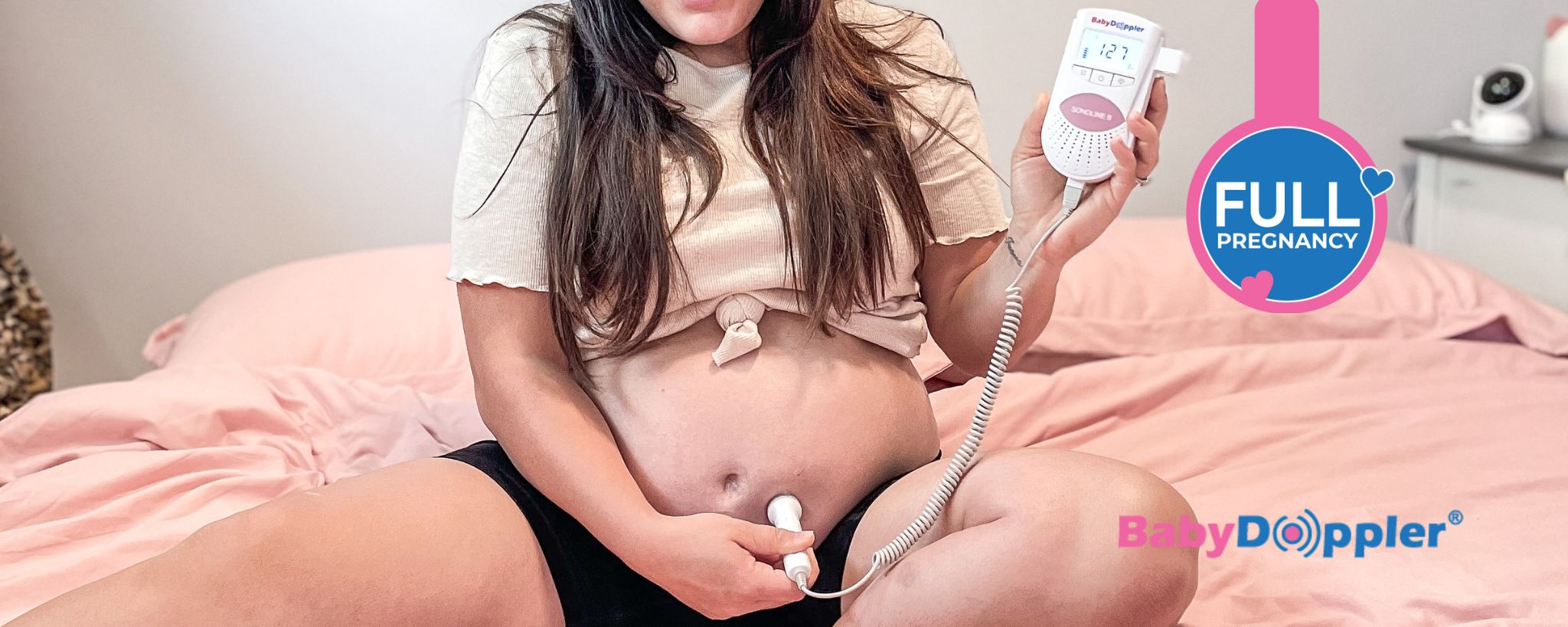If you’ve already ordered your Sonoline B fetal doppler, you probably can’t wait to hear your baby.
While you’re waiting for your device to arrive in the mail, keep this resource handy.
In this guide, you’ll learn everything you need to know to use your fetal doppler for the first time. From instructions to tips and troubleshooting, we’ve got you covered.
Why Use Fetal Doppler Sonoline B?
There’s plenty of reasons parents use fetal dopplers. Here’s a quick list:
- Parents enjoy monitoring their baby’s heartbeats between doctor’s appointments. Although fetal dopplers don’t replace medical advice, you may begin to notice a pattern in your baby’s heartbeat. If you think you hear the heartbeat deviating from that pattern, you can call your doctor or midwife and ask for advice.
- Send doctor clips. Your fetal doppler Sonoline B can be used with the BabyDoppler app, allowing you to record the heartbeat. If you think you hear a problem in your baby’s heartbeat, you can record it and send the file to your doctor for evaluation. This option is helpful for anxious parents between appointments, especially if you have a complicated pregnancy.
- Another layer of reassurance. Along with counting kicks, fetal dopplers may act as another layer of reassurance between appointments. As long as everything else is okay, hearing a heartbeat can be a calming experience, letting you know your baby is still healthy.
- Bonding for mom. One of the biggest reasons moms love at-home fetal dopplers is because of the bonding experience they provide. Hearing your baby’s heartbeat allows you to better connect with her before birth.
- Bonding for family members. Fetal dopplers also provide the rare opportunity for the non-pregnant partner to bond. Without being pregnant, pregnancy not might feel “real” yet. Hearing the heartbeat provides an opportunity for the other partner to connect with their developing baby. It’s also a great way to explain to children that their sibling is growing inside you.
- Create keepsakes. Fetal dopplers also create keepsakes to cherish for lifetimes to come. Simply use the app to record the heartbeat and save the file forever. Share it with your baby when they grow older or email it to relatives who can’t see your pregnancy in person.
When to Use Fetal Doppler At Home
The Sonoline B fetal doppler starts working around 12 weeks of pregnancy. On average, that’s when a baby is big enough to detect.
Some parents detect a heartbeat as early as 9 weeks, although it shouldn’t be expected. Other parents need to wait a few more weeks, until week 13 or 14, to reliably detect their baby. Remember that your ability to detect your baby depends on how big she is and her position. For that reason, you may need to wait more or less time—and that’s completely normal.
How Often Should I Use a Fetal Doppler?
How often you use your at-home fetal doppler is up to you. Many parents enjoy a few weekly sessions.
There’s no evidence that extended use of fetal dopplers can harm your baby. Fetal dopplers use similar technology to ultrasound; however, dopplers are significantly less powerful. Since the ultrasound waves emitted are lower, they should pose even less risk than an ultrasound.
Still, fetal doppler sessions shouldn’t be longer than a few minutes. While there’s no evidence of harm, there’s a few reasons why you shouldn’t continuously use one. Here’s our suggestions:
- Use your fetal doppler a few times a week, keeping it under 10 minutes per session
- If you feel the need to continuously use your fetal doppler (without medical advice), put it away for a while until you feel less anxious and more confident in your baby’s health. Do not continue using your doppler if it’s increasing your anxiety.
- If you can’t detect the heartbeat yet, put it away for a day. Don’t continuously use it.
How to Use Your Fetal Doppler Sonoline B
Using a Sonoline B fetal doppler is simple.
You’ll need:
- Your Sonoline B fetal doppler
- Ultrasound gel (comes with free sample)
- Paper towels
Step-by-step instructions:
- Recline back on a chair, sofa, or bed
- Apply a blob of ultrasound gel on your lower belly
- Stick the probe into the gel and turn the device on
- Rock your probe in an angled fashion across your stomach, starting from the bottom and moving up. Do this slowly so you don’t miss a spot.
- Stop when you hear the heartbeat.
- Optional: Record and track the heartbeat using the BabyDoppler app
Tips for Finding Fetal Doppler Heartbeat
If you can’t find your baby’s heartbeat, it could mean your baby has switched positions. Below are a few things you can do to make finding the heartbeat easier.
- Full bladder. Use your fetal doppler on a full bladder. This helps push your uterus out of the pelvic cavity, making the heartbeat easier to find.
- Be generous with ultrasound gel. Be generous with the ultrasound gel. Too little can cause too much feedback.
- …But not too generous. Too much ultrasound gel can also make it difficult to hear your baby, so don’t overdo it.
- Ensure you’re reclined. When you lay back, your uterus is propped up, making it easier to detect. If your uterus isn’t pushed out enough, it may be difficult.
- Change probe. Plus-sized people might have an easier time finding a heartbeat with a 2MHz probe. Get a 2MHz probe here.
Learn more by reading: 10 Must-Know Secret Tips for Finding Fetal Heartbeat with Doppler
Tips for Discerning Fetal Doppler Heartbeat
While fetal dopplers are easy to use, it’s more of a challenge to know which noise is your baby’s heartbeat. Other sounds your fetal doppler picks up include:
- Your heartbeat
- Placenta
- Arterial sounds
- Baby movement
Luckily, with practice, it can be second nature. Below are our suggestions for discerning the fetal heartbeat.
- Compare heart rate ranges. Check the screen for the heart rate. A normal adult heart rate ranges from 60-80 bpm. A normal fetal heart rate ranges from 120-180 bpm. (Learn more by reading: Normal Fetal Doppler Heart Rate Ranges)
- Placenta noise. You may know when you’re detecting the placenta because it sounds like whooshing, blowing trees, or a “wowowow” sound.
- Fetal heartbeat noise. Many describe the sound of a fetal heartbeat as similar to galloping horses or jumping rope very rapidly.
- Watch videos. Watch BabyDoppler’s videos to learn the sound of a fetal heartbeat.
Learn more by reading: Heartbeat or Another Noise? 8 Tips to Discern Fetal Doppler Noises
Fetal Doppler Problems & Solutions
Find the solution to common fetal doppler problems below.
Problem: I Haven’t Been Able to Detect a Heartbeat. Help!
If you haven’t detected your baby’s heartbeat yet, she may be too small still. Even if your doctor used their fetal doppler to detect the heartbeat, it’s still possible you may not hear it on an at-home fetal doppler yet. That’s because the device used in-office may be stronger and your doctor is well-trained. If you can’t hear a heartbeat, put the fetal doppler away and try again next week.
Problem: I Detected a Heartbeat Before but Not Now. Help!
If you detected a heartbeat before but not now, don’t panic. There’s several normal reasons this can happen. The most common reason is that your baby has switched positions. This can make it difficult for the at-home fetal doppler to pick up. Another possibility is that your baby is still too small to be reliably detected. In the beginning, you may find her sometimes but not others.
Problem: I Think Something is Wrong. Help!
If you can’t detect your baby’s heartbeat anymore and you think something is wrong, contact your doctor or seek emergency care. If you detect your baby’s heartbeat and it sounds abnormal, you should also contact your doctor or seek emergency care. Another option is to use the BabyDoppler app to record the presumed abnormality. Send the clip to your doctor and ask for their advice. You can also use the device over a facetime call with your doctor.
Problem: Why Do I Hear Two Heartbeats?
Unless you’re having twins, if you hear two heartbeats in different places, one is likely an echo. When this is the case, the echo is usually within 10 bpm of the real heartbeat.
Problem: There’s Too Much Feedback
Too much feedback could mean you’re using too little or too much ultrasound gel. It could also mean you purchased a cheap device. Fetal Dopplers on Amazon are often low-quality, creating too much feedback, making them unusable. Make sure to purchase a reliable device, like the affordable, industry-trusted Sonoline B fetal doppler.
Problem: I Ran Out of Ultrasound Gel
All of BabyDoppler’s devices come with a free sample of ultrasound gel so you can get started right away. We also sell full-sized bottles of ultrasound gel for your continued use. Although they probably won’t work as well, in a pinch, you can use alternatives. Learn more by reading: Doppler Without Gel? 8 Ultrasound Gel Alternatives At Home
Get Your Fetal Doppler Today!
Sonoline B fetal dopplers are an industry-trusted brand with high-quality but affordable models. For under $60, you can hear your baby’s heartbeat at home!



